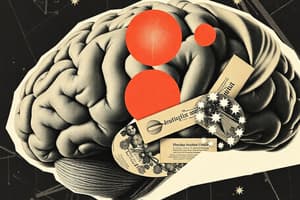Podcast
Questions and Answers
What is the primary function of the thalamus in the cerebral cortex?
What is the primary function of the thalamus in the cerebral cortex?
- To process and store sensory information
- To control the dominant and non-dominant hemispheres
- To regulate the intellectual functions of the prefrontal association area
- To connect each area of the cortex to a specific part of the thalamus (correct)
What percentage of the population has a left dominant hemisphere?
What percentage of the population has a left dominant hemisphere?
- 85%
- 75%
- 95% (correct)
- 99%
What is the result of damage to the dominant Wernicke's area?
What is the result of damage to the dominant Wernicke's area?
- Dementia (correct)
- Easily distracted and inability to think logically
- Inability to store new information
- Loss of music and sensory feelings
What is the primary role of the prefrontal association area?
What is the primary role of the prefrontal association area?
What is the characteristic of Wernicke's area in the dominant hemisphere?
What is the characteristic of Wernicke's area in the dominant hemisphere?
What is the result of damage to the prefrontal association area?
What is the result of damage to the prefrontal association area?
What is the possible mechanism of immediate memory?
What is the possible mechanism of immediate memory?
What is the result of repetitive stimulation?
What is the result of repetitive stimulation?
What is the role of cAMP in the molecular basis for memory?
What is the role of cAMP in the molecular basis for memory?
What is the result of long-term memory?
What is the result of long-term memory?
What is the process of converting immediate into short- and long-term memory?
What is the process of converting immediate into short- and long-term memory?
What is the role of the hippocampus in memory?
What is the role of the hippocampus in memory?
What is the primary function of the prefrontal association area?
What is the primary function of the prefrontal association area?
What is the significance of the quote from Pink Floyd in the context of brain function?
What is the significance of the quote from Pink Floyd in the context of brain function?
Which area of the brain is responsible for forming words that express a particular thought?
Which area of the brain is responsible for forming words that express a particular thought?
What is the role of the arcuate fasciculus in language processing?
What is the role of the arcuate fasciculus in language processing?
What is the primary function of Wernicke's area?
What is the primary function of Wernicke's area?
What is the final step in the pathway for auditory communication?
What is the final step in the pathway for auditory communication?
What is the primary function of the primary auditory area?
What is the primary function of the primary auditory area?
Which area of the brain is responsible for the full interpretation of visual input?
Which area of the brain is responsible for the full interpretation of visual input?
What is the result of the destruction of the visual and auditory association areas?
What is the result of the destruction of the visual and auditory association areas?
What is the purpose of the pathway that transmits signals to the motor cortex?
What is the purpose of the pathway that transmits signals to the motor cortex?
What is the role of the parietal-temporal-occipital association cortex?
What is the role of the parietal-temporal-occipital association cortex?
What is the name of the aphasia caused by the destruction of the visual and auditory association areas?
What is the name of the aphasia caused by the destruction of the visual and auditory association areas?
What is the primary function of Wernicke's area?
What is the primary function of Wernicke's area?
Which hemisphere is responsible for understanding spoken words?
Which hemisphere is responsible for understanding spoken words?
What happens when the fibers of the corpus callosum are interrupted?
What happens when the fibers of the corpus callosum are interrupted?
What is the neural mechanism for thought?
What is the neural mechanism for thought?
What is the definition of memory?
What is the definition of memory?
What is the longest-lasting type of memory?
What is the longest-lasting type of memory?
Flashcards are hidden until you start studying
Study Notes
Physiologic Anatomy of Cerebral Cortex
- Each area of the cortex is connected to a specific part of the thalamus.
- Thalamic connection is necessary for cortical function; loss of thalamic connection stops cortical function.
- All sensory pathways pass through the thalamus, except for the olfactory tract.
Dominant and Non-Dominant Hemisphere
- Wernicke's area is more developed in one hemisphere, responsible for verbal symbolism and related intelligence.
- 95% of the population has a left dominant hemisphere.
- Wernicke's area can be up to 50% larger in the dominant hemisphere.
- Damage to the dominant Wernicke's area leads to dementia.
- The non-dominant side is related to other forms of sensory intelligence (music, sensory feelings).
Intellectual Functions of the Prefrontal Association Area
- Responsible for calling forth stored information and using it to obtain a goal.
- Responsible for concerted thinking in a logical sequence.
- Damage causes inability to keep track of simultaneous bits of information and easily distracted.
- Elaboration of thought, prognostication, planning, and consideration of consequences of motor actions before they are performed.
- Correlates widely divergent information and controls one's activities.
Function of the Brain in Communication
- Pathways for auditory communication involve:
- Primary auditory area recognition of the sound as a word.
- Interpretation of the word and the thought that the word expresses in Wernicke's area.
- Formation of the word that expresses a particular thought.
- Transmission via the arcuate fasciculus to Broca's area for control of word formation.
- Activation of motor programs in Broca's area for control of speech muscles.
- Transmission of signals to motor cortex to control speech muscles.
Pathways for Visual Communication
- Pathways for visual communication involve:
- Receive the visual input in the primary visual area.
- Processing of the visual information in the parietal-temporal-occipital association cortex, the angular gyrus region.
- Visual input reaches full level of interpretation in Wernicke's area.
- Transmission to Broca's area for motor formation of the word.
- Transmission of signals to motor cortex to control speech muscles.
Sensory Aspects of Communication
- Wernicke's aphasia results from destruction of the visual and auditory association areas, leading to an inability to understand the written or spoken word.
Motor Aspects of Communication
- Speech involves two things: formation in the mind of thoughts to be expressed and the choice of words, and motor control of vocalization and the act of vocalization.
- Formation of word, thought, and choice of words is a function of Wernicke's area.
- Broca's area controls the motor coordination required for speech.
Function of the Corpus Callosum
- Connects the two hemispheres and allows transfer of information.
- Interruption of these fibers can lead to bizarre types of anomalies.
- Dominant hemisphere understands spoken word, while non-dominant hemisphere understands written word and can elicit motor response without dominant side knowing why response was performed.
Thoughts and Memory
- Neural mechanism for thought is not known, but most likely a specific pattern of simultaneous neural activity in many brain areas.
- Destruction of cerebral cortex does not prevent one from thinking, but may reduce the depth of thought and level of awareness.
Memory
- Change in the capability of synaptic transmission from neuron to neuron as a result of prior stimulation.
- Memory trace is a specific pattern or pathway of signal transmission.
- Once established, they can be activated by the thinking mind to reproduce the pattern and thus the memory.
3 Types of Memory
- Immediate memory: lasts for seconds or minutes.
- Short-term memory: lasts for days to weeks.
- Long-term memory: lasts for years or for a lifetime.
Mechanism of Memory
- Immediate memory may result from synaptic potentiation through the accumulation of calcium in the presynaptic membrane.
- Short-term memory may result from a temporary physical or chemical change in the pre- or postsynaptic membrane.
Cellular Basis for Memory
- Repetitive stimulation causes a progressive decline in sensitivity called habituation.
- Habituation results from progressive decline in the number of active calcium channels.
- Stimulation of facilitator terminal prevents habituation.
Molecular Basis for Memory
- Transmitter activates G protein, which in turn activates adenylate cyclase, resulting in an increase in cAMP.
- cAMP activates a protein kinase that phosphorylates a component of the K+ channel, blocking its activity.
- This prolongs the action potential, which increases transmitter release.
Long-Term Memory
- Results from a structural change in the synapse.
- Increase in the area for vesicular release, therefore, more transmitter is released.
- During periods of inactivity, the area decreases in size.
- Enlargement of the release site area results from synthesis of release site proteins.
Consolidation of Memory
- Converting immediate into short- and long-term memory.
- Results from chemical, physical, and anatomical changes in the synapse.
- Requires time and can be interrupted by electrical shock or anesthesia.
- Rehearsal enhances consolidation.
Brain Centers for Memory
- Hippocampus is critical for long-term memory.
- Damage causes inability to form new verbal or symbolic long-term memory, known as anterograde amnesia.
Studying That Suits You
Use AI to generate personalized quizzes and flashcards to suit your learning preferences.



